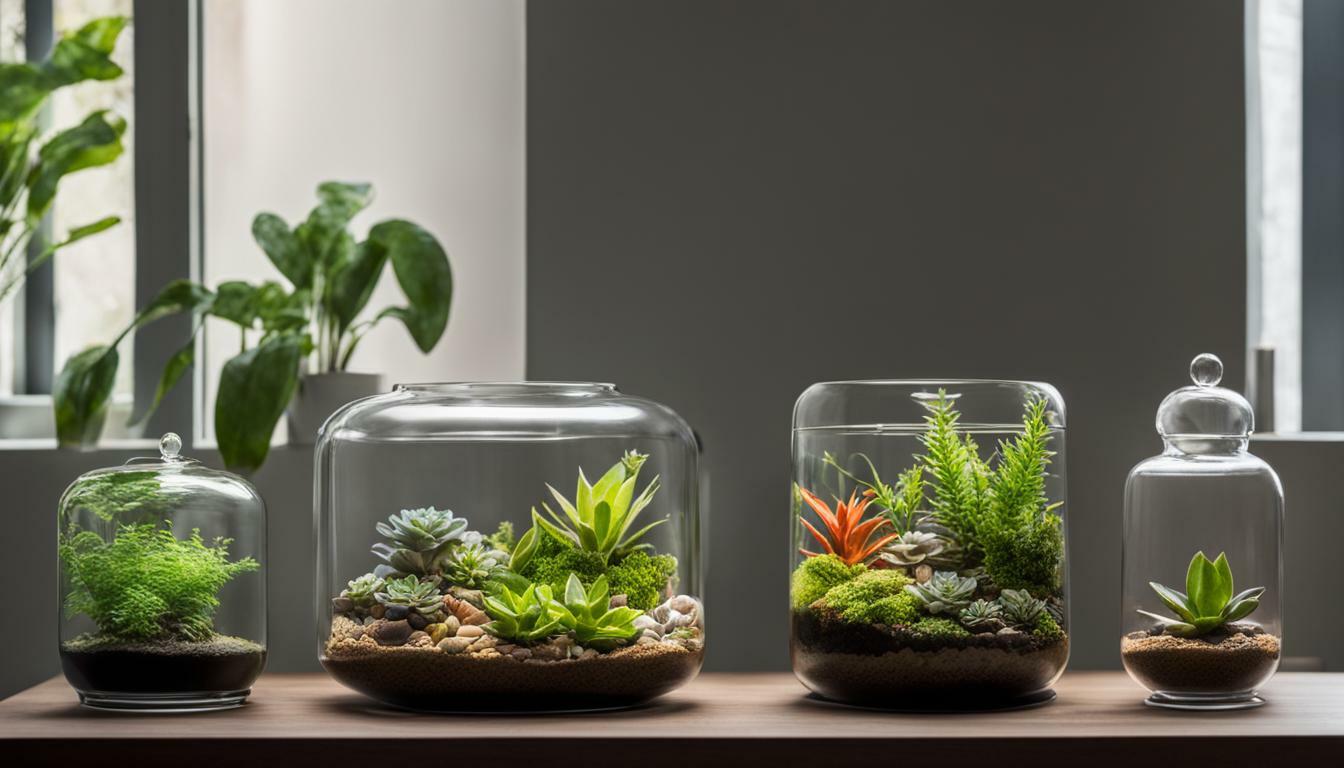Lighting plays a crucial role in ensuring the health and vitality of your terrarium. The right amount and quality of light are essential for the growth and well-being of terrarium plants. In this comprehensive guide, we will explore the various light requirements for terrarium care, providing you with all the information you need to create the perfect lighting conditions for your terrarium.
- For closed terrariums, place them in a location with good natural light, avoiding direct sunlight to prevent excessive condensation.
- Monitor the moisture levels in your terrarium and adjust watering accordingly, only when plants show signs of dryness.
- Control mold and fungus growth by wiping off any visible mold and providing proper air circulation.
- Prune or replace tall plants to maintain the desired size and shape of your terrarium.
- Observe your terrarium regularly, making necessary adjustments to ensure the plants receive the proper amount and quality of light.
Understanding the light requirements for terrariums is essential for successfully growing and maintaining healthy plants. Whether you are using natural or artificial lighting, it’s important to consider factors such as intensity, duration, and the specific needs of different types of terrarium plants. By providing the right lighting conditions, you can ensure the long-term health and beauty of your terrarium.
Understanding Terrarium Light Conditions
Terrariums require specific light conditions to thrive, and understanding these conditions is essential for successful terrarium care. Whether you have an open or closed terrarium, providing the right amount and quality of light is crucial for the health and growth of your plants. In this section, we will explore some key terrarium lighting tips and the best light conditions for terrariums.
For closed terrariums, it is recommended to place them in a location with good natural light. However, direct sunlight should be avoided as it can lead to excessive condensation, which may harm your plants. Instead, opt for a spot with bright, indirect light that mimics the conditions found in the natural environment of your terrarium plants.
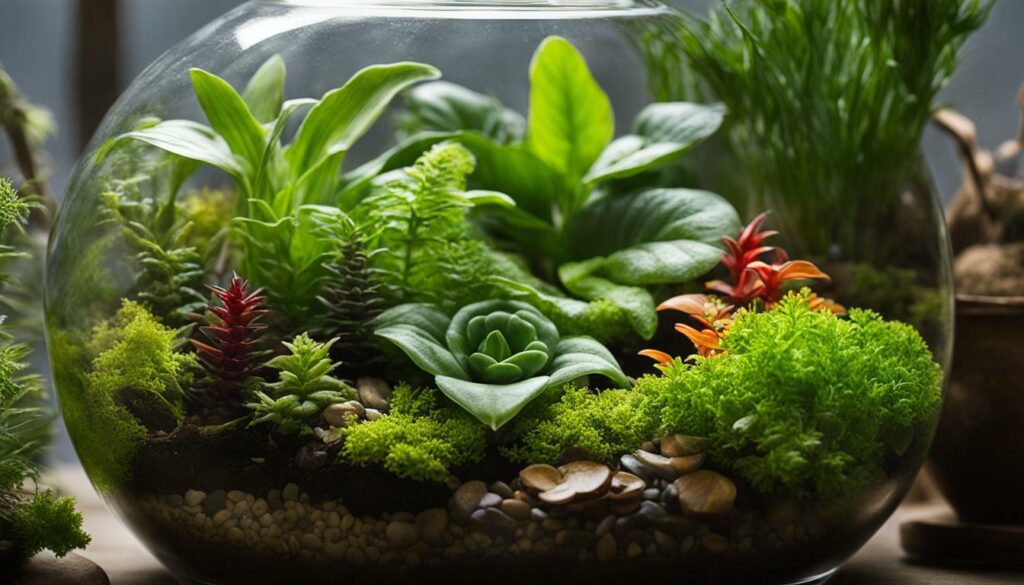
When it comes to the intensity and duration of light, different types of terrarium plants have varying requirements. It is advisable to measure light intensity using a luxmeter or simply observe the shadows cast by your hand. As a general guide, ferns require 1000-1500 lux for 10-12 hours per day, moss needs 500-1000 lux for 8-10 hours per day, orchids thrive with 1500-3000 lux for 10-14 hours per day, carnivorous plants require 3000-5000 lux for 12-16 hours per day, succulents do well with 5000-10000 lux for 12-16 hours per day, and air plants prefer 3000-5000 lux for 10-14 hours per day.
It is important to monitor the light conditions in your terrarium and make adjustments as necessary. If natural light is not sufficient, you can supplement it with artificial lighting. Positioning the lights properly and selecting the right light spectrums are key factors to consider when using artificial lighting for your terrarium.
Light Intensity and Duration for Terrariums
The intensity and duration of light are crucial factors in maintaining optimal growth and development in terrarium plants. Different types of plants have varying light requirements, and it is important to provide the right amount and quality of light for each species. To ensure your terrarium plants thrive, it is essential to understand how to measure light intensity and determine the appropriate duration of light exposure.
When it comes to measuring light intensity, luxmeters are a handy tool to have. These devices help quantify the amount of light reaching your plants, allowing you to adjust the light source as needed. Alternatively, you can also gauge light intensity by observing the shadows cast by your hand. If the shadow is clear and crisp, the light intensity is sufficient. However, if the shadow appears blurry or faint, it indicates low light intensity, which may not be suitable for some plants.
As for light duration, the recommended hours per day vary depending on the type of plant. Ferns, for example, thrive with 10-12 hours of bright, indirect light, while carnivorous plants require 12-16 hours of intense lighting. It is important to note that most terrarium plants benefit from a period of darkness as well, so be sure to allow for some downtime without artificial lights.
| Terrarium Plant | Recommended Light Intensity (Lux) | Recommended Light Duration (Hours) |
|---|---|---|
| Ferns | 1000-1500 | 10-12 |
| Moss | 500-1000 | 8-10 |
| Orchids | 1500-3000 | 10-14 |
| Carnivorous Plants | 3000-5000 | 12-16 |
| Succulents | 5000-10000 | 12-16 |
| Air Plants | 3000-5000 | 10-14 |
Remember that these are general guidelines, and it is always best to research the specific requirements of your terrarium plants to ensure their optimal health and growth. By providing adequate light intensity and duration, you can create a thriving and beautiful terrarium ecosystem.
Natural Light Requirements for Terrariums
Harnessing natural light can provide the ideal conditions for terrariums, but precautions must be taken to ensure the best outcomes. Terrariums, whether open or closed, require different lighting conditions to support plant growth and overall health. For closed terrariums, it is best to place them in a location with good natural light, but direct sunlight should be avoided as it can cause excessive condensation. The average room temperature is suitable for closed terrariums, and if there is too much condensation, temporarily removing the lid can help reduce moisture.
Watering a terrarium should be done when the plants show signs of dryness, as there isn’t a set schedule for watering. Mold and fungus can sometimes occur in terrariums, but they can be controlled by wiping off any mold and ensuring proper air circulation. While certain types of mushrooms can grow in terrariums, they can be left alone or carefully removed with gloves and tweezers. To reduce mold and spores, neem oil can be used.
Other potential pests, such as fungus gnats, can be reduced by removing excess soil and allowing the terrarium to dry out. If the plants in the terrarium grow too tall, they can be pruned or replaced with smaller plants. Regular maintenance, including removing dead leaves and cleaning decorative elements, is important for the overall health of the terrarium. Observing the plants and making necessary adjustments is crucial to ensure their longevity and well-being.
| Terrarium Plant | Light Requirement (lux) | Light Duration (hours per day) |
|---|---|---|
| Ferns | 1000-1500 | 10-12 |
| Moss | 500-1000 | 8-10 |
| Orchids | 1500-3000 | 10-14 |
| Carnivorous Plants | 3000-5000 | 12-16 |
| Succulents | 5000-10000 | 12-16 |
| Air Plants | 3000-5000 | 10-14 |
When it comes to lighting requirements, most terrarium plants thrive under bright, indirect light. Placing the terrarium near a window or using reflective surfaces to enhance the amount of light can help achieve this. It is important to consider the intensity and duration of light, which can be measured using luxmeters or by observing the shadows cast by your hand.
Artificial Lighting Options for Terrariums
Artificial lighting can be a valuable tool in providing consistent and controlled light for terrarium plants. When natural light is insufficient or not readily available, artificial lights can ensure that your terrarium plants receive the necessary amount and quality of light to thrive. Here, we will explore different options for artificial lighting and provide guidance on choosing the right light for your terrarium.
When selecting artificial lights for your terrarium, it is important to consider the light spectrum, intensity, and duration. LED grow lights are a popular choice as they offer a wide range of light spectrums to cater to different plant needs. Full-spectrum LED lights provide a balanced combination of red, blue, and white light, which is essential for photosynthesis and overall plant growth. They are energy-efficient, long-lasting, and emit little to no heat, making them ideal for enclosed terrariums.
“LED grow lights provide a balanced combination of red, blue, and white light, which is essential for photosynthesis and overall plant growth.”
For terrariums with specific plants that require higher light intensity, high-intensity discharge (HID) lights, such as metal halide and high-pressure sodium lights, can be used. These lights emit intense light that mimics sunlight and promotes vigorous growth. However, they produce more heat and consume more energy compared to LED lights, so proper ventilation and monitoring of the terrarium’s temperature is crucial.
When it comes to selecting the proper intensity and duration of artificial light, it is recommended to refer to the specific light requirements of your terrarium plants. Different types of plants have varying light needs, and it is essential to match their requirements to ensure optimal growth. A luxmeter or observing the shadows cast by your hand can help gauge light intensity. Additionally, using timers for your artificial lights can help maintain consistent light cycles and prevent overexposure or underexposure.
Remember to regularly observe your terrarium plants and make adjustments as necessary. Monitor their growth, check for signs of inadequate lighting or light burn, and make any necessary changes to the light placement or intensity. By providing the right artificial lighting, you can create a thriving and visually stunning terrarium ecosystem.
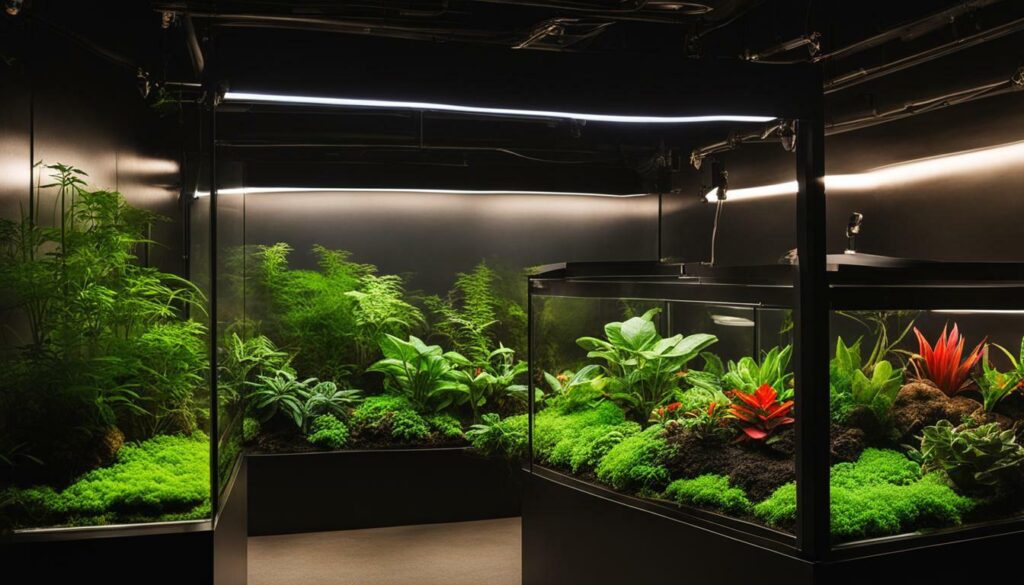
Different terrarium plants have unique light requirements, and understanding these requirements is essential for their overall well-being. The right amount and quality of light can directly impact plant growth and vitality. When it comes to terrariums, finding the perfect balance of light is crucial for creating a thriving microclimate.
To ensure your terrarium plants receive adequate light, it’s important to consider factors such as light intensity and duration. Light intensity can be measured using luxmeters or simply by observing the shadows cast by your hand. Duration refers to the number of hours per day that your terrarium should be exposed to light.
Here are some general guidelines for popular terrarium plants:
| Type of Plant | Light Requirement (Lux) | Duration (Hours/Day) |
|---|---|---|
| Ferns | 1000-1500 | 10-12 |
| Moss | 500-1000 | 8-10 |
| Orchids | 1500-3000 | 10-14 |
| Carnivorous Plants | 3000-5000 | 12-16 |
| Succulents | 5000-10000 | 12-16 |
| Air Plants | 3000-5000 | 10-14 |
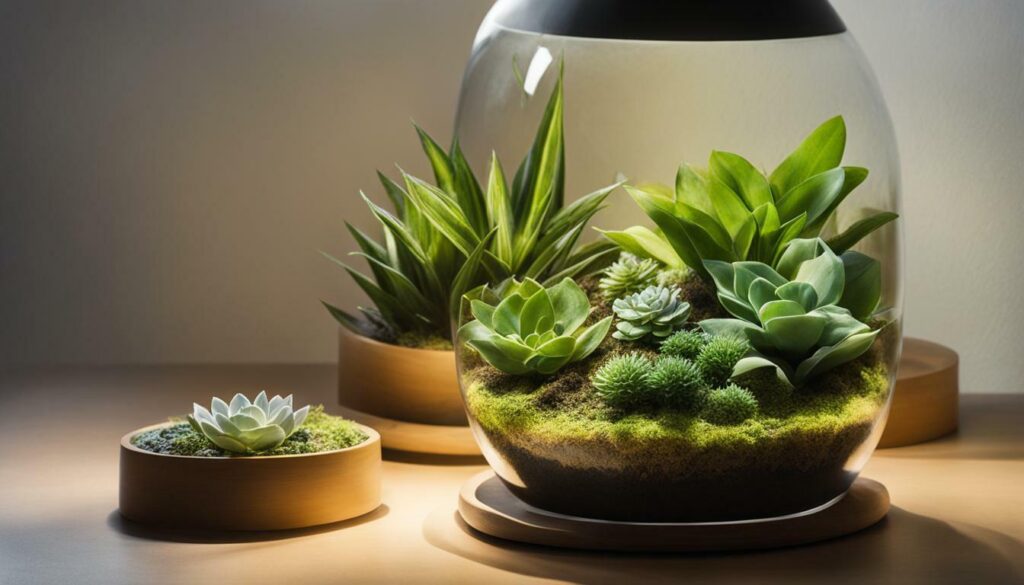
If natural light is not sufficient, artificial lighting can be used to supplement the lighting requirements for your terrarium plants. This can be particularly useful in spaces with limited access to sunlight or during the winter months when daylight hours are shorter. With the right artificial light source, you can provide the necessary light spectrum for optimal plant growth.
Remember to monitor your terrarium plants closely and make adjustments as needed. If you notice signs of inadequate light, such as yellowing leaves or stunted growth, consider increasing the light intensity or duration. On the other hand, if you observe signs of light burn, such as brown spots on leaves, reduce the light intensity or adjust the placement of your terrarium.
Managing Mold and Fungus Growth
Mold and fungus can pose challenges to terrarium care, but with the right approach, they can be effectively managed. Proper lighting plays a crucial role in preventing the growth of mold and fungus in your terrarium. Providing your plants with the right amount and quality of light can create an environment that discourages these unwanted microorganisms.One of the key factors to consider is the light spectrum. Different plants have varying light requirements, and understanding their specific needs can help you maintain a healthy terrarium. Some plants thrive in low light conditions, while others require more intense light. By ensuring that your plants receive the appropriate light spectrum, you can create an environment where mold and fungus are less likely to grow.To control mold and fungus growth, it is important to maintain proper air circulation within your terrarium. Stagnant air can create a breeding ground for these microorganisms. You can achieve good air circulation by occasionally removing the lid of your closed terrarium or strategically placing an open terrarium in a well-ventilated area. Additionally, wiping off any visible mold or fungus with a damp cloth can help keep their growth in check.Neem oil can be a useful tool in managing mold and spores in your terrarium. This natural oil has antifungal properties and can be applied to affected areas. However, it is important to follow the instructions provided with the neem oil and use it sparingly to avoid any adverse effects on your plants.In summary, by providing the right light spectrum, maintaining proper air circulation, and taking proactive measures to control mold and fungus growth, you can ensure the health and longevity of your terrarium plants. Regular observation and adjustments are key to addressing any issues that may arise and maintaining a thriving terrarium ecosystem.| Terrarium Plant | Light Requirement (Lux) | Duration (Hours per Day) |
|---|---|---|
| Ferns | 1000-1500 | 10-12 |
| Moss | 500-1000 | 8-10 |
| Orchids | 1500-3000 | 10-14 |
| Carnivorous plants | 3000-5000 | 12-16 |
| Succulents | 5000-10000 | 12-16 |
| Air plants | 3000-5000 | 10-14 |
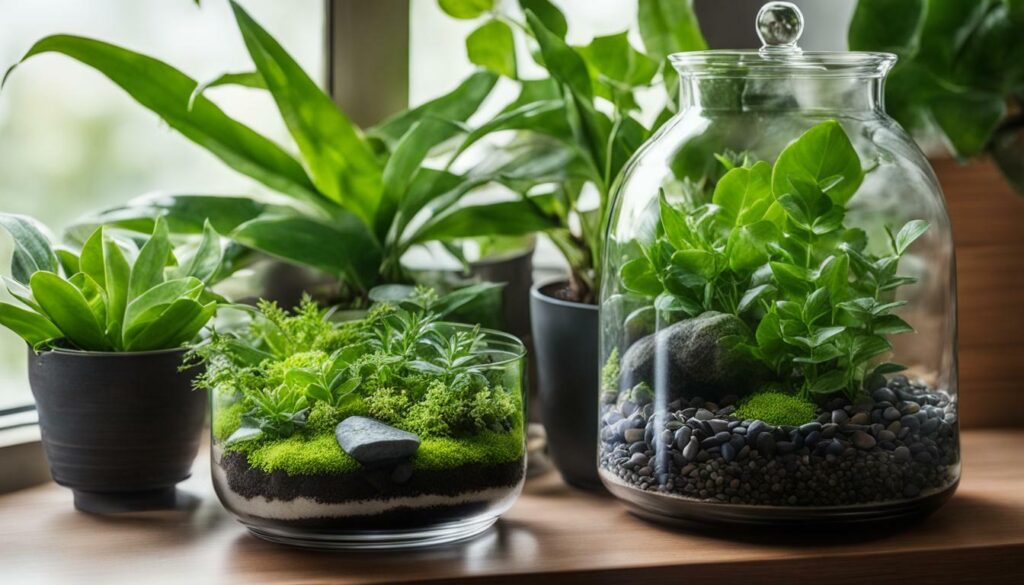
Dealing with Pests in Terrariums
Pests can disrupt the harmony of your terrarium, but proactive measures can keep them at bay. It is important to maintain proper lighting conditions and implement strategies to prevent pest infestations. By following these steps, you can ensure the health and longevity of your terrarium plants.
First, it is essential to monitor your terrarium regularly. Look out for signs of pests such as fungus gnats, which are small flies that thrive in moist environments. To reduce their presence, remove any excess soil and allow the terrarium to dry out between waterings. This not only discourages gnats but also helps prevent mold and fungus growth.
Additionally, consider the use of natural deterrents. Neem oil, derived from the neem tree, is a natural insecticide that can be effective against various pests. Dilute the oil according to the instructions and apply it to the affected areas of the terrarium. This can help control pests and reduce the spread of mold and spores.
Lastly, maintaining proper air circulation is crucial. Stagnant air can create an environment conducive to pest infestations. Place the terrarium in a well-ventilated area, and consider using a small fan to promote air movement. This will help keep pests at bay and create a healthier environment for your terrarium plants.
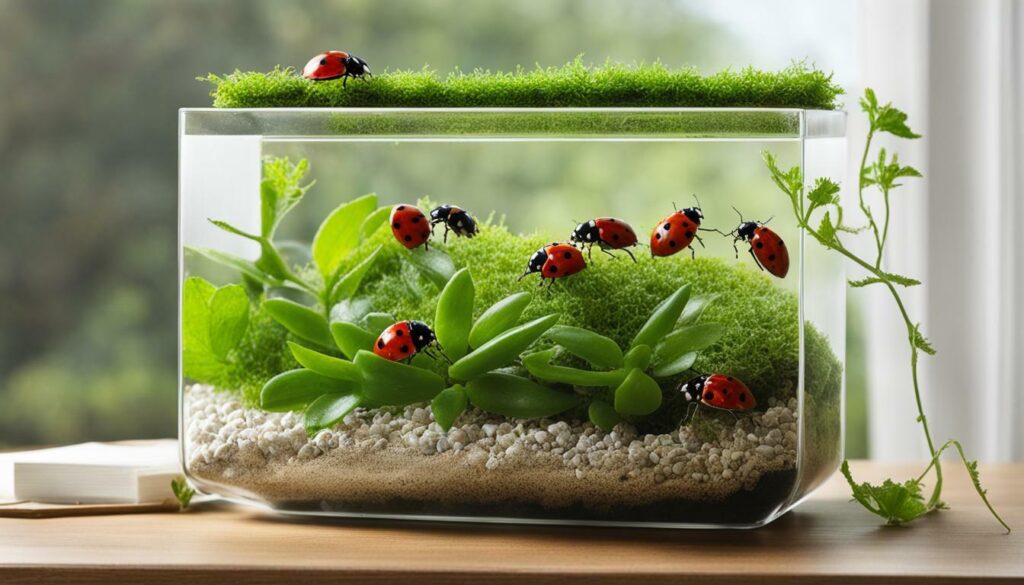
| Terrarium Plant | Light Requirements |
|---|---|
| Ferns | 1000-1500 lux for 10-12 hours per day |
| Moss | 500-1000 lux for 8-10 hours per day |
| Orchids | 1500-3000 lux for 10-14 hours per day |
By following these guidelines, you can create an environment that promotes the health and well-being of your terrarium plants while minimizing the risk of pest infestations. Remember to observe your terrarium regularly, implement preventative measures, and make necessary adjustments to maintain suitable light conditions. With proper care, your terrarium can thrive and be a beautiful addition to your home or office.
Pruning and Maintenance for Terrarium Plants
Regular maintenance is vital for ensuring the long-term health and aesthetics of your terrarium plants. By following a few simple practices, you can keep your terrarium thriving and looking beautiful. Here are some tips for pruning and maintaining your terrarium plants:
Trimming Overgrown Plants
As your terrarium plants grow, they may start to outgrow their designated space. To maintain the desired size and shape, it’s important to trim back any overgrown foliage. Use a pair of clean, sharp scissors or pruning shears to carefully remove the excess growth. Be sure to remove any dead or yellowing leaves as well, as they can be a breeding ground for pests and disease.
Removing Dead Leaves
Dead leaves can accumulate in a terrarium over time, affecting the overall appearance and health of the plants. Regularly check your terrarium for any dead leaves and gently pluck them out. Removing dead leaves not only improves the aesthetics but also prevents the spread of any potential diseases or pests that may be harboring in them.
Cleaning Decorative Elements
In addition to maintaining the plants, it’s essential to keep the decorative elements in your terrarium clean. Dust and debris can accumulate on rocks, pebbles, or other decorative items, detracting from the overall visual appeal. Periodically remove the decorative elements and rinse them with water to keep them looking fresh and vibrant.
Remember, each terrarium is unique, and its maintenance needs may vary based on the types of plants and the environmental conditions. Regular observation, adjustment, and care are key to ensuring the longevity and beauty of your terrarium plants. By following these pruning and maintenance practices, you can enjoy a thriving and visually stunning terrarium for years to come.
| Plants | Light Requirements |
|---|---|
| Ferns | 1000-1500 lux for 10-12 hours per day |
| Moss | 500-1000 lux for 8-10 hours per day |
| Orchids | 1500-3000 lux for 10-14 hours per day |
| Carnivorous plants | 3000-5000 lux for 12-16 hours per day |
| Succulents | 5000-10000 lux for 12-16 hours per day |
| Air plants | 3000-5000 lux for 10-14 hours per day |
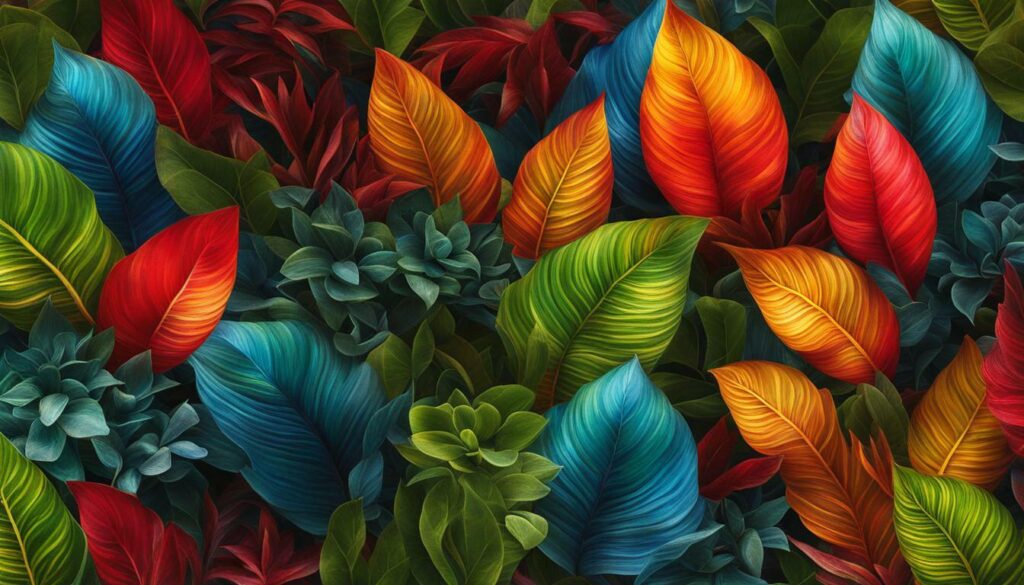
Observing and Adjusting Terrarium Light Conditions
Monitoring and adjusting light conditions are essential for maintaining a thriving terrarium. Proper lighting is crucial for photosynthesis, which is the process plants use to convert light into energy. By observing and adjusting the light conditions in your terrarium, you can ensure that your plants receive the optimal amount and quality of light they need to thrive.
One way to monitor light conditions is by measuring the intensity of light using a luxmeter or by simply observing the shadows cast by your hand. Different types of plants have different light requirements, so it’s important to consider the specific needs of the plants in your terrarium. As a general guide, ferns require 1000-1500 lux for 10-12 hours per day, moss requires 500-1000 lux for 8-10 hours per day, orchids require 1500-3000 lux for 10-14 hours per day, carnivorous plants require 3000-5000 lux for 12-16 hours per day, succulents require 5000-10000 lux for 12-16 hours per day, and air plants require 3000-5000 lux for 10-14 hours per day.
If natural light is not sufficient for your terrarium, you can supplement it with artificial lighting. There are various types of artificial lights available, such as fluorescent, LED, and grow lights. When using artificial lighting, it’s important to consider the light spectrum and ensure that it provides the necessary wavelengths for plant growth. Reflective surfaces can also be used to enhance the amount of light reaching the plants. By experimenting with different lighting setups and observing how your plants respond, you can make adjustments to create optimal light conditions for your terrarium.
| Type of Plant | Required Light Intensity (Lux) | Recommended Light Duration (Hours per Day) |
|---|---|---|
| Ferns | 1000-1500 | 10-12 |
| Moss | 500-1000 | 8-10 |
| Orchids | 1500-3000 | 10-14 |
| Carnivorous Plants | 3000-5000 | 12-16 |
| Succulents | 5000-10000 | 12-16 |
| Air Plants | 3000-5000 | 10-14 |
Summary:
Observing and adjusting terrarium light conditions is crucial for the health and growth of your plants. By monitoring the light intensity and duration, you can ensure that your terrarium receives the optimal amount of light. Different types of plants have different light requirements, so it’s important to consider their specific needs. If natural light is not sufficient, you can supplement it with artificial lighting, making sure to choose the right light spectrum. By experimenting and making adjustments, you can create the ideal light conditions for your terrarium and promote the thriving growth of your plants.
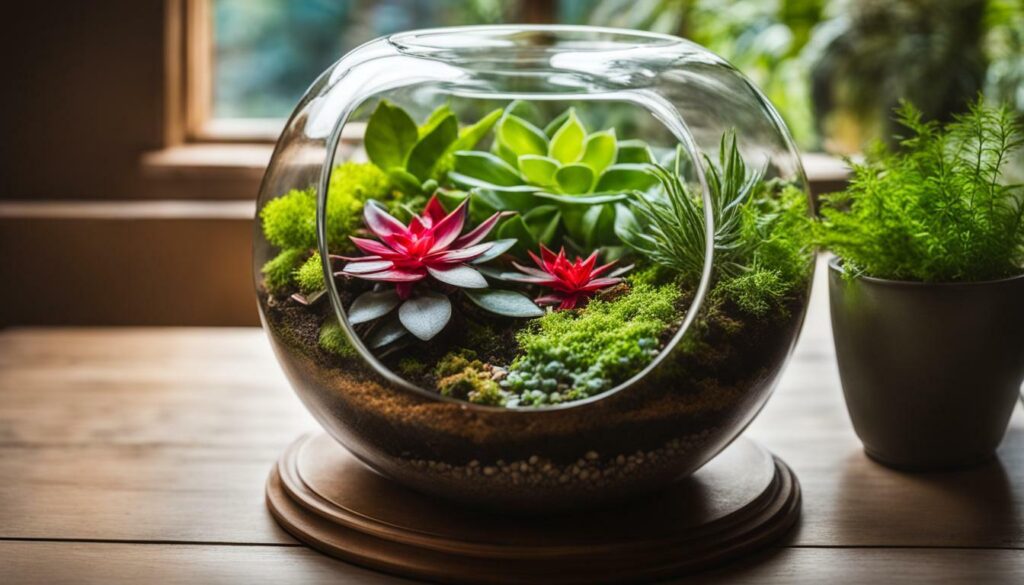
Artificial lighting can be an effective solution to provide consistent light for your terrarium, especially in low-light environments. When natural light sources are limited or unavailable, artificial lights can ensure that your terrarium plants receive the necessary light spectrum and intensity to thrive. There are a variety of options to choose from when it comes to artificial lighting for terrariums, each with its own advantages and considerations.
One popular choice is LED lights, which are energy-efficient and easily adjustable. LED lights come in different color temperatures, allowing you to customize the light spectrum for specific plant needs. They also produce less heat, reducing the risk of overheating your terrarium. Fluorescent lights, such as T5 or T8 bulbs, are another option to consider. They provide a broad spectrum of light and are suitable for a wide range of terrarium plants.
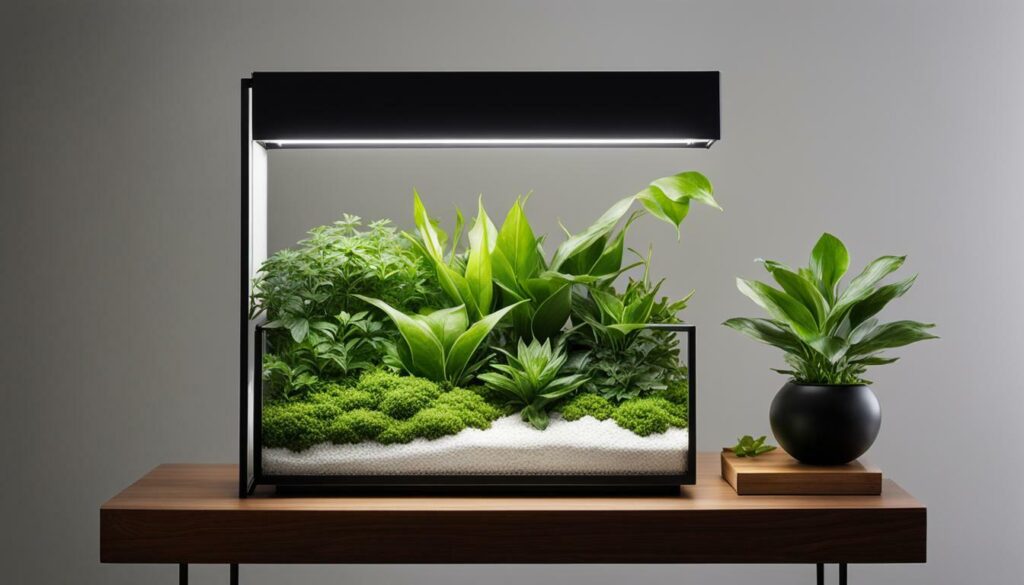
When selecting artificial lighting for your terrarium, it is important to consider the light intensity and duration. Different plants have varying light requirements, so it’s essential to match the lighting conditions to their specific needs. The intensity of light can be measured using a luxmeter or by observing the shadows cast by your hand. As a general guide, ferns require 1000-1500 lux for 10-12 hours per day, moss requires 500-1000 lux for 8-10 hours per day, orchids require 1500-3000 lux for 10-14 hours per day, carnivorous plants require 3000-5000 lux for 12-16 hours per day, succulents require 5000-10000 lux for 12-16 hours per day, and air plants require 3000-5000 lux for 10-14 hours per day.
Remember to position the artificial lights at an appropriate distance from your terrarium to avoid heat stress and provide even coverage. Use reflectors or white surfaces to maximize light distribution within the terrarium. Monitor your plants closely and make adjustments as needed to ensure they are receiving the proper amount and quality of light for optimal growth.
How Important is Proper Lighting for Terrarium Care?
Proper lighting is crucial for terrarium care decorations upkeep. It ensures that plants receive the necessary light for photosynthesis and growth. By providing the right amount of light, you can create a healthy environment for your terrarium and enhance the overall appearance of your decorations.
Conclusion
Meeting the light requirements of your terrarium plants is essential for their overall health and vitality. Terrariums, whether open or closed, require different lighting conditions to thrive. For closed terrariums, it is best to place them in a location with good natural light, avoiding direct sunlight to prevent excessive condensation. The average room temperature provides an ideal environment for closed terrariums. If condensation becomes excessive, temporarily removing the lid can help reduce moisture.
Watering your terrarium should be done when the plants show signs of dryness, rather than on a set schedule. Mold and fungus can occasionally develop in terrariums, but they can be controlled by wiping off any mold and providing proper air circulation. If mushrooms appear, they can be left alone or carefully removed with gloves and tweezers. Neem oil can help reduce mold and spores.
Pests such as fungus gnats can be annoying but can be reduced by removing excess soil and ensuring the terrarium dries out. If plants in the terrarium grow too tall, they can be pruned or replaced with smaller plants. Regular cleaning and maintenance, such as removing dead leaves and cleaning decorative stones, will keep your terrarium looking its best.
When it comes to lighting requirements, bright indirect light is ideal for most terrarium plants. Placing the terrarium near a window or using reflective surfaces can enhance the amount of light. It is important to consider the intensity and duration of light, which can be measured using luxmeters or by observing the shadows cast by your hand.
Different types of plants have different light requirements. As a general guide, ferns require 1000-1500 lux for 10-12 hours per day, moss requires 500-1000 lux for 8-10 hours per day, orchids require 1500-3000 lux for 10-14 hours per day, carnivorous plants require 3000-5000 lux for 12-16 hours per day, succulents require 5000-10000 lux for 12-16 hours per day, and air plants require 3000-5000 lux for 10-14 hours per day.
If natural light is not sufficient, artificial lights can be used to supplement the lighting. It is crucial to monitor your terrarium plants and make adjustments as necessary to ensure they are receiving the proper amount and quality of light. By providing the right lighting conditions, you can create a thriving and beautiful terrarium ecosystem for your plants to flourish.
FAQ
What lighting conditions are best for closed terrariums?
Closed terrariums should be placed in a location with good natural light, but avoid direct sunlight. The average room temperature is ideal for closed terrariums.
How often should I water my terrarium?
Watering a terrarium is not on a set schedule but should be done when the plants show signs of dryness.
How can I control mold and fungus in my terrarium?
Mold and fungus can be controlled by wiping off any mold and providing proper air circulation. Neem oil can also be used to reduce mold and spores.
What should I do if mushrooms grow in my terrarium?
Certain types of mushrooms can grow in a terrarium. They can be left alone or removed carefully with gloves and tweezers.
How can I reduce pests like fungus gnats in my terrarium?
To reduce pests like fungus gnats, remove excess soil and dry out the terrarium.
What should I do if the plants in my terrarium grow too tall?
If plants in the terrarium grow too tall, they can be pruned or replaced with smaller plants.
How do I clean and maintain my terrarium?
Terrariums may require cleaning and maintenance, such as removing dead leaves and cleaning decorative stones.
What is the ideal light for most terrarium plants?
The ideal light for most terrarium plants is bright, indirect light.
How can I measure light intensity and duration for my terrarium?
Light intensity can be measured using luxmeters or by observing the shadows cast by your hand. The duration of light exposure varies for different types of plants.
Can artificial lights be used for terrariums?
Yes, artificial lights can be used to supplement the lighting for terrariums that do not receive sufficient natural light.
What should I do if I notice inadequate lighting for my terrarium plants?
If you notice signs of inadequate lighting in your terrarium, such as stunted growth or pale leaves, adjustments can be made by changing the positioning or intensity of the light source.

